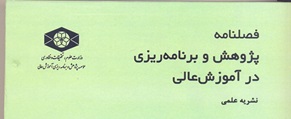تعیین خطمشیها و عوامل اثرگذار در ارزشیابی درونی گروههای آموزشی: رویکردی براساس پویایی سیستم
نویسندگان
1 مرکز مطالعات سازمان سنجش آموزش کشور
2 رئیس مرکز مطالعات سازمان سنجش آموزش کشور و گروه علوم کامپیوتر دانشگاه شهید بهشتی
چکیده
چارچوب پژوهش حاضر بر اساس کاربرد روششناسی پویایی سیستم در ارزشیابی درونی شکل گرفته است. هدف از این پژوهش پیشنهاد مدلی به منظور بررسی و تعیین خطمشیها و عوامل اثرگذار در کیفیت گروههای آموزشی با استفاده از روششناسی پویایی سیستمها بوده است. بر این اساس، ابتدا عواملی چون عضو هیئت علمی، دانشجو، دانش آموخته، پذیرفتهشده، پژوهش، تدریس، دورههای تحصیلی، بودجه، امکانات و تجهیزات آموزشی و پژوهشی و امکانات و تجهیزات رفاهی به عنوان مؤلفههای اثر گذار بر کیفیت گروه از مطالعات نظری، پژوهشهای قبلی و تحلیل عناصر یک گروه آموزشی استخراج و سپس، بر اساس متغیرهای اثرگذار در هر عامل و روابط بین آنها مدلی کلی برای شبیهسازی رفتار گروه آموزشی طراحی شد. مدل طراحی شده پس از تعیین اعتبار رفتاری و ساختاری با دادههای یک گروه مفروض مورد آزمایش قرار گرفت. با اجرای مدل در یک دوره چهار ساله و با توجه به مقادیر اولیه متغیرها و روابط میان آنها در گروه مفروض مشاهده شد که گروه روندی توسعهای را در پیش گرفته است. با استفاده از این مدل میتوان علاوه بر بررسی نتایج و پیامدهای حاصل از اعمال خطمشیهای پیشنهادی تصمیمگیران، میزان تأثیر متغیرها را در کیفیت گروه مطالعه کرد. در نتیجه، مدیران و تصمیمگیران میتوانند از مدل پیشنهادی مانند آزمایشگاهی برای بررسی و آزمون سیاستها و خطمشیهای خود استفاده کنند.
کلیدواژهها
عنوان مقاله [English]
Policy-Making and Factors Affecting Internal Evaluation of Departments: A System Dynamics Approach
نویسندگان [English]
- Arash Bahrami 1
- Gholamreza Yadegarzadeh 1
- Korosh Paran 2
1 Department of Evaluation, National Organization of Educational Testing (NOET)
2 Chief of NOET Research Center and Department of Computer Science, Shahid Beheshte Univeristy
چکیده [English]
The present research is based on the application of system dynamics in internal evaluation. It aims to present a model in which policies and factors affecting quality in educational departments are investigated and determined, using system dynamics methodology.
In the first step, factors having an impact on the quality of departments are selected based on relevant research theories, previous studies and factor analysis of departments. The factors include: faculty members, students,… members of the department, students, graduates, admitted students, research, teaching and learning educational programs, budget and educational and research equipment and facilities.
In the second step, a general model is suggested to simulate the behavior of a department according to variables relevant to each factor. Then, the structural and behavioral validity of the model is tested against departmental hypothetical data.
Finally, the simulated model is applied over a four-year span of time. Results indicate an improving trend in the quality of the departments supposed.
The model can be used for analysis of not only the efficiency and effectiveness of the policies proposed by decision-makers but also the effectiveness of each variable in Promotion of the quality of a department. Therefore, such a model provides a simulating tool for managers and decision-makers to test and assess their policies and strategies.
کلیدواژهها [English]
- system dynamics
- Modeling
- Simulation
- Internal Evaluation
- Quality improvement
- and Higher Education
 فصلنامه پژوهش و برنامه ریزی در آموزش عالی
فصلنامه پژوهش و برنامه ریزی در آموزش عالی
